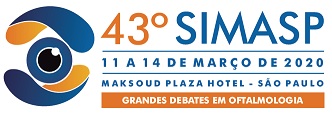Dados do Trabalho
Título
CONGENITAL CRANIAL DYSINNERVATION DISORDER PRESENTED AS DUANE’S SYNDROME: A CASE REPORT.
Introdução
Congenital cranial dysinnervation disorder (CCDD) is a term used to define a group of congenital and non-progressive disorders, wich includes conditions like Duane's syndrome.
In Duane's syndrome, it is believed that there is an aberrant innervation of the oculomotor nerve in relation to the lateral rectum, with the clinical presentation of co-contraction of the lateral rectum and medial rectum in an adduction attempt, resulting in retraction of the globe and consequent narrowing of the cleft eyelid. The lateral rectus muscle may receive little or no innervation from the abducens nerve.
Métodos
Report a case according to patients files
Resultados
Male, 5 years old, with divergent strabismus in the right eye, since 4 months of life. On examination, he presented corrected visual acuity of 20/40 (RE) and 20/20 (LE), divergent strabismus of the RE with 45D deviation (near and far commutant), adduction limitation of the right eye -6 with upshoot. Initially, treatment included occlusion for about 6 hours a day, to improve RE amblyopia. The child underwent surgical correction.
In the intraoperative period, strong contracture and malformation of the musculature was observed, with agenesis of the lateral rectum and with the upper and lower rectus muscles assuming an oblique position, converging towards the insertion of the absent lateral rectum.
Both vertical rectus of the right eye were retracted by 9mm, maintaining their oblique direction in order to avoid vertical deviation in the primary position. In the recent postoperative period, it evolved with XT 25D, and after 1 month there was recurrence of the deviation (XT 40DP), downshoot and adduction limitation -2. Child follows treatment for amblyopia and parents are advised about reserved prognosis for recovery of conjugated look.
Conclusões
The patient had clinical manifestations compatible with Duane's syndrome. However, unlike the typical clinical sings and symptons, during the surgery, the lateral rectus muscle was not found in its anatomical insertion. Probably, the limitation of adduction and up / downshoot are due to the contracted vertical straight muscles with oblique insertion.
These anomalies of the extrinsic ocular musculature, as hypoplasia, anomalous insertion or its fibrotic replacement, are within the panorama of CCDD. The muscle without neuronal tone and trophism, during the embryonic period, would undergo involution or, in counterpart, anomalous contraction.
Palavras Chave
strabismus; exotropia; Duane retraction syndrome
Arquivos
Área
Miscelânea
Instituições
HOSPITAL OFTALMOLÓGICO DE BRASÍLIA - Distrito Federal - Brasil
Autores
JADY FOGANHOLO, ISADORA FERRO NOGUEIRA, JÉSSICA THAÍS CAMPOS LOPES GONÇALVES, LAURA DAYANE MOREIRA DE JESUS, LIANE DE MOURA SANTOS PEREIRA FERRAZ BAPTISTA, NATHANAEL SOUSA ABREU
